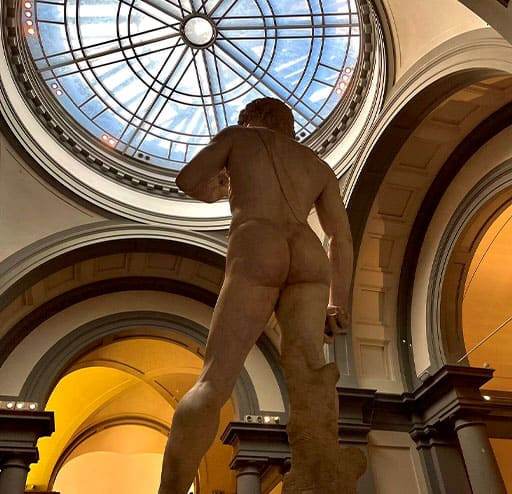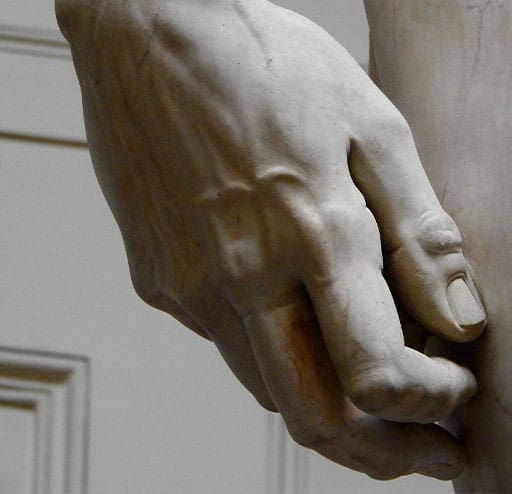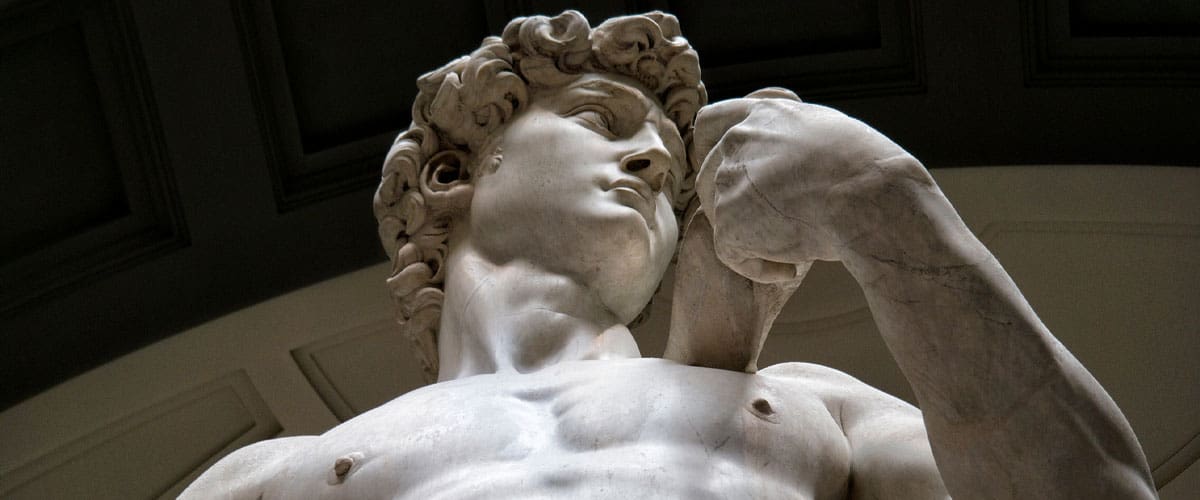
Michelangelo’s Statue of David: More Than Just a Beautiful Statue
In this comprehensive guide, we’ll explore the fascinating story behind the Michelangelo’s Statue of David, from its creation to its impact on art and culture.
Michelangelo’s Statue of David: The Ultimate Guide
The Creation of the Michelangelo’s Statue of David
In 1501, the Florentine government commissioned a young Michelangelo Buonarroti to create a monumental statue for the Cathedral of Florence. The challenge? He had to work with a massive block of marble, nicknamed “The Giant,” which had been abandoned by two previous sculptors, Agostino Di Duccio and Antonio Rossellino.
This block had been excavated 40 years earlier and left exposed to the elements. Many considered it too flawed for a masterpiece, but 26-year-old Michelangelo saw potential where others saw problems. Enthusiastically accepting the challenge, he was determined to bring the biblical hero David to life from this imperfect stone.
For nearly three years, Michelangelo worked tirelessly on the statue. Unlike many sculptors who first created small models, Michelangelo began carving directly into the marble. He worked in relative secrecy, hidden behind wooden screens to shield his progress from prying eyes.
Michelangelo famously described the process as “seeing the angel in the marble and carving until I set him free,” but the reality was far from poetic. The creation of David demanded Herculean strength, meticulous precision, and almost infinite patience.
Initially commissioned as one of several sculptures to adorn Florence Cathedral’s roofline, David’s placement was reconsidered after its completion. Due to its exceptional artistic merit, influential figures, including the Signoria, Florence’s governing body, and prominent artists like Giorgio Vasari, chose a more public and symbolic location. The statue was placed in front of the Palazzo Vecchio in Piazza della Signoria, the heart of Florence and the seat of the city’s government. There, it served as a powerful representation of civic virtue and republican ideals.
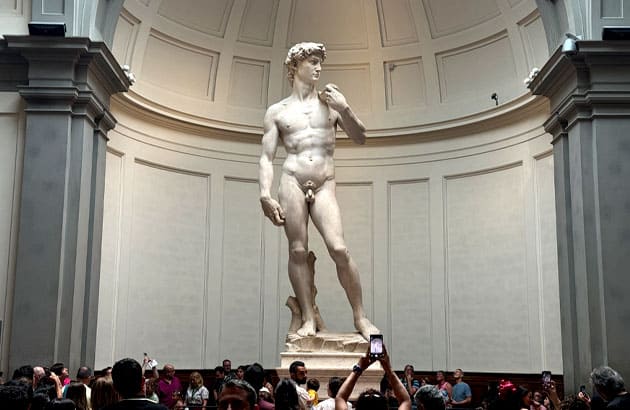
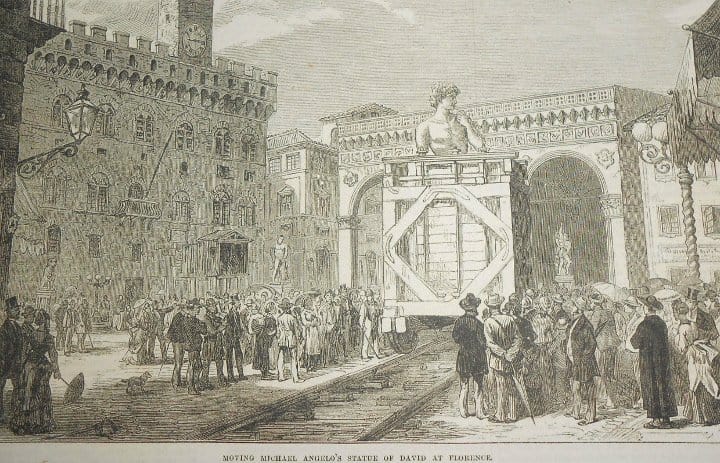
When the statue was unveiled in 1504, it left the people of Florence awestruck. Michelangelo had transformed a discarded block of marble into a figure of such power and beauty that it defined an era.
For over two centuries, David stood as a guardian in Piazza della Signoria, a symbol of Florentine pride. In 1873, to preserve this irreplaceable treasure, the statue was moved indoors to the Accademia Gallery, where it could be protected from the elements and admired in controlled conditions.
Artistic Analysis of the Michelangelo’s Statue of David
Standing before the statue of David, one is immediately struck by its towering height of 17 feet (5.17 meters). Despite its imposing stature, the statue has grace and delicacy. Every muscle, vein, and contour of David’s body is carved with astonishing accuracy.
The hands seem ready to flex, and the slight twist of the torso creates a sense of potential energy. This is as if David might step off his pedestal at any moment.
However, it’s not just the physical details that make the statue a masterpiece. David’s face, with its furrowed brow and intense gaze, captures a moment of deep concentration. He looks to his left, presumably eyeing his opponent, Goliath, with an expression that combines determination with uncertainty.
Unlike earlier sculptures of David that showed him triumphant after victory, Michelangelo chose to represent the moment before the battle.
Every element of the statue, from the barely visible sling over David’s left shoulder to the tree stump supporting his right leg, was carefully considered. Even the proportions, which may seem slightly off to the modern eye (with an oversized head and hands), were intentional. Michelangelo designed the statue to be viewed from below, adjusting the proportions to appear correct from that angle.
Accademia Gallery Skip-the-Line Guided Tours
Accademia Gallery Timed Entry Tickets
Historical Context of the Michelangelo’s Statue of David
To fully appreciate the statue of David, we must understand the world in which it was created. In the early 16th century, Florence was a vibrant hub of artistic and intellectual activity, with the Renaissance in full swing and the city at its heart.
Florence at this time was a place of contradictions. It was a proud republic, fiercely protective of its independence, yet constantly threatened by more powerful states and internal factions. The city was deeply religious while embracing humanist ideals that celebrated human potential. It was a center of trade and banking, yet also a cradle of art and philosophy.
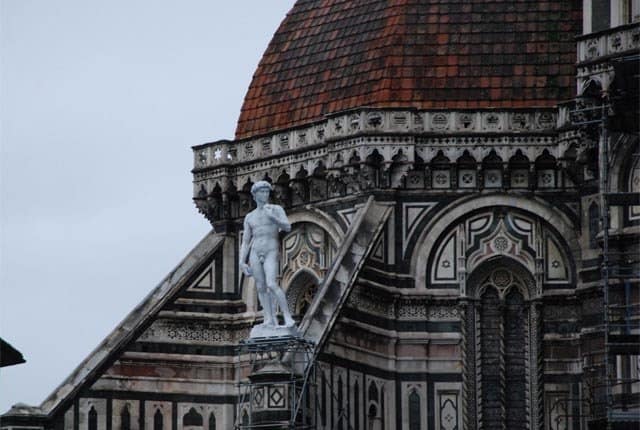
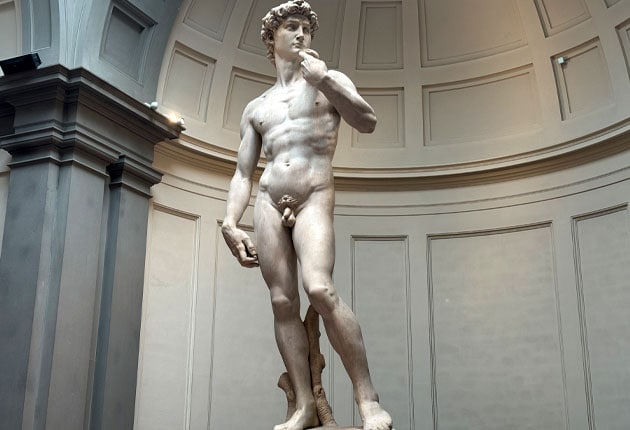
The biblical story of David resonated deeply with the Florentines. Like David facing Goliath, Florence saw itself as a small but courageous entity standing up to larger, more powerful foes. Choosing David as the subject for such a monumental work was no accident; it was a statement of Florentine identity and aspiration.
Michelangelo’s interpretation of David was revolutionary. Previous depictions often showed David after his victory, typically with Goliath’s severed head. Michelangelo chose instead to capture the moment before the battle, emphasizing David’s courage and resolve rather than his triumph.
This approach perfectly aligned with the humanist ideals of the Renaissance. The statue of David celebrated human potential, portraying its subject not as a divinely assisted victor but as a man relying on his strength and wit to face a formidable challenge.
The political significance of the statue was immediate and lasting. Initially intended for the Cathedral, the sculpture was ultimately placed in front of the Palazzo Vecchio, the city’s governmental headquarters.
This location transformed the statue from a purely religious symbol into a political one, representing Florence’s republican ideals and its readiness to defend its liberty.
In many ways, the statue of David embodied the spirit of Renaissance Florence: classical in inspiration, innovative in execution, and imbued with civic pride and artistic genius. It stood as a testament to what humans could achieve as individuals and as a society.
The Statue of David’s Impact on Renaissance Art
For the artists of the time, the statue set a new standard of excellence. Its anatomical accuracy, emotional expressiveness, and technical virtuosity raised the bar for what sculpture could achieve. Many artists travelled to Florence specifically to study the statue, sketching it from various angles to understand how Michelangelo had accomplished such a feat.
The influence of the statue of David is evident in the work of numerous Renaissance artists. Raphael, for instance, incorporated elements of David’s pose into some of his painted figures. Younger sculptors like Baccio Bandinelli and Bartolomeo Ammannati created their own versions of David, but none quite matched the impact of Michelangelo’s masterpiece.
Michelangelo’s ability to infuse stone with life and emotion demonstrated the expressive potential of sculpture, challenging artists to explore new possibilities in the medium.
Moreover, the statue of David influenced the concept of public art. Its placement in a civic space, rather than a religious one, set a precedent for art that could address both secular and spiritual concerns. This idea of art serving a civic function would have far-reaching implications, influencing public art commissions for centuries.
Preservation and Restoration of the Michelangelo’s Statue of David
Preserving a 500-year-old marble statue is no small feat, and the statue of David has faced numerous challenges over the centuries
One of the primary challenges in preserving the statue is its material. While prized for its beauty, Carrara marble is relatively soft and porous, making it susceptible to damage from pollution, vibration, and even oils from human hands.
The statue of David has undergone several major restorations throughout its history. One of the most significant occurred between 2003 and 2004, in preparation for the sculpture’s 500th anniversary. This restoration involved cleaning the statue using distilled water and cellulose pulp poultices, a gentle method that removed accumulated grime without damaging the marble.
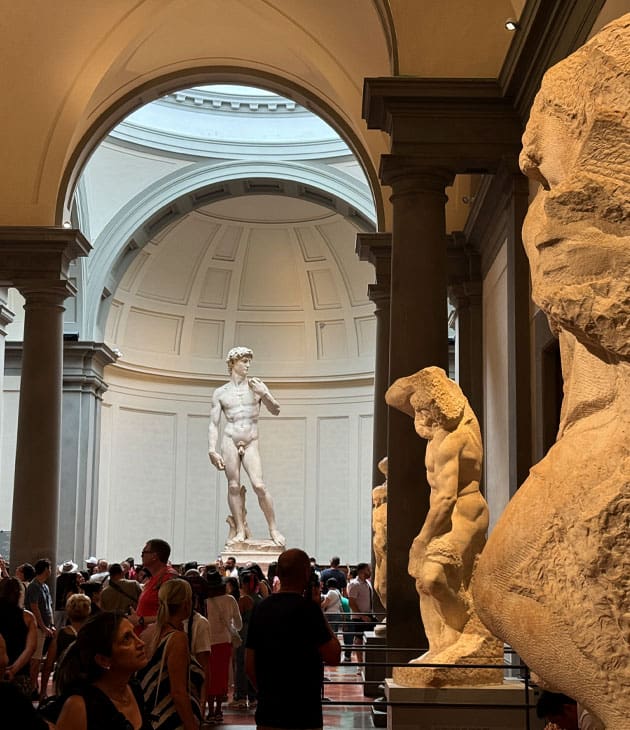

During this restoration, scientists thoroughly analysed the statue’s condition and discovered micro-fractures in the legs and ankles, likely due to the marble’s inherent flaws and the statue’s slightly forward-leaning posture. To address these issues, restorers applied a special lime-based grout to stabilize the weakened areas.
Current conservation techniques for the statue of David focus on preventative measures. The sculpture is now housed in a climate-controlled environment in the Galleria dell’Accademia, protecting it from outdoor pollutants and temperature fluctuations. Vibration monitors track any potentially damaging movements, whether from foot traffic or distant sources like construction or earthquakes.
Each restoration effort and conservation measure ensures that future generations will continue to experience the awe and inspiration that Michelangelo’s masterpiece has provided for over five centuries.
Visiting the Michelangelo’s Statue of David: What You Need to Know
For art lovers planning a trip to Florence, seeing the statue of David in person is often a top priority. Here’s what you need to know to make the most of your visit.
The original Michelangelo’s Statue of David is housed in the Galleria dell’Accademia, located in the heart of Florence. This museum was built around the statue, providing a spacious, well-lit home that allows visitors to appreciate it from all angles.
When planning your visit, booking tickets in advance is crucial, especially during peak tourist seasons. The Galleria dell’Accademia is one of Florence’s most popular attractions, and wait times can be long if you don’t have a reservation.
Once inside, take your time approaching the statue of David. It’s positioned at the end of a long gallery, allowing for a dramatic reveal as you walk towards it. Many visitors find it helpful to circle the statue slowly, taking in different perspectives. Don’t forget to look up – the statue’s height is truly awe-inspiring when seen from below.
While the Michelangelo’s Statue of David is undoubtedly the star attraction, the Galleria dell’Accademia houses other notable works worth exploring. Michelangelo’s unfinished “Prisoners” sculptures provide a fascinating insight into his working process.
For those interested in seeing other versions of the Statue of David, there are two replicas in outdoor locations in Florence. A marble copy stands before the Palazzo Vecchio, where the original was initially displayed. Another replica, made of bronze, is located in Piazzale Michelangelo, offering stunning views over the city.
Accademia Gallery Skip-the-Line Guided Tours
Accademia Gallery Timed Entry Tickets
all the copies of Michelangelo’s Statue of David in the world
Around 1870, there was a growing belief that Michelangelo’s work should be preserved inside the walls of a museum, and Clemente Papi was commissioned to create a copy of David to be placed in Piazza della Signoria. While the artist was forging his bronze David, workers built a carriage to transport the original to the Accademia Gallery. It took five scorching days in August 1873 to complete the operation!
David arrived at the Accademia without any damage, where we can still admire it in all its splendour today. And what about the copy in Piazza della Signoria?
The Florentines strongly criticized Papi’s bronze copy because it was not faithful to the original. As a result, it was moved to Piazzale Michelangelo, along with the bronze copies of Night, Day, Twilight, and Dawn from the Medici Chapels.
Piazza della Signoria remained without its iconic symbol for several years until the early 1900s when the second marble copy, created by Luigi Arrighetti, was placed there. Have you ever wondered how many copies of David have been made throughout history?
Excluding all those sold in souvenir shops, there are 16 1:1 copies of this extraordinary sculpture. They are scattered worldwide: in London, Copenhagen, Antwerp, Los Angeles, Las Vegas, Philadelphia, California, Australia, and India…
Pictures of the Michelangelo’s Statue of David
Learn more about the statue of david by michelangelo
Here are 10 things you should know about the statue of david by michelangelo
Based on what historical figure was Michelangelo’s Statue of David modelled after?
In this sculpture, Michelangelo drew inspiration from the Biblical tale of David, a shepherd boy who slew a giant with just a sling and a handful of stones to save the Israelites.
What was the purpose of Michelangelo’s creation of David?
In his early twenties when he was commissioned to create a statue representing the biblical hero David, Michelangelo Buonarroti (1475 – 1564) was in his early twenties when he was commissioned to create this statue. An offer was made to him to work on a colossal block of marble which had previously been carved by two other artists, Agostino di Duccio (in 1464) and Antonio Rossellino (in 1475).
Is there a reason for David’s hand to be so big?
Despite Michelangelo’s mastery of human anatomy, David still possesses a few anatomical defects that may be attributed to him. It has been suggested that the right-hand features an enlarged abductor digit minimi in order to draw attention to the stone as a symbol of his courage and physical strength than the left hand.
What is David holding in his left hand?
In the Bible, the Bible tells us that when David went to fight Goliath he took his shepherd’s staff, five smooth stones, and his sling with him. There are two kinds of slings, and only the latter is represented in Michelangelo’s sculpture, as David holds the pouch of the sling with his left hand, above his shoulder, as shown in the sculpture.
What happened to David’s toes?
Michelangelo’s David, probably the most famous sculpture in the world, has been damaged in a Florence museum today when a man who police describe as being deranged broke a part of a toe with a hammer, claiming that a 16th-century Venetian painter’s model instructed him to do so.
Where is the real statue of the David by Michelangelo?
The Galleria dell’Accademia di Firenze, or “Gallery of the Academy of Florence”, is a museum of art that is located in Florence, Italy. One of the most famous sculptures in the world is Michelangelo’s David, which is on display at the museum. There are also other sculptures by Michelangelo in the museum, as well as a large collection of paintings by Florentine artists, most of which date from the period from 1300 to 1600.

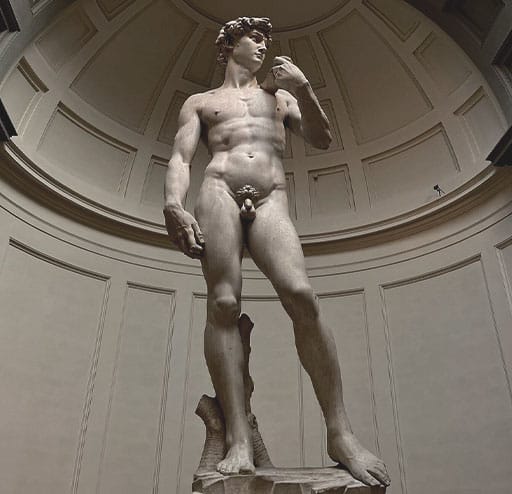


How tall is the statue of David by Michelangelo?
His height of David is 5.16 meters (nearly 17 feet, which is a bit short at 16 feet and 11.15 inches).
Are there two statues of David?
Currently, there are three statues of David within the Vatican that maintain Michelangelo’s visionary sculpting and are one authentic statue and two replica statues.
Why is David the symbol of Florence?
This David is the symbol of the fight that the Florentines waged against the Medici and they adopted it as their own symbol. The cathedral authorities decided in 1504 that Michelangelo’s creation was too majestic to be placed so high up on the structure. As a result, it was relocated to a much more convenient place, near the Palazzo della Signoria, the main square in the city, than its previous location.
How did David influence the Renaissance?
As with Michelangelo’s earlier masterpiece Pieta (1498-9) he had just completed in Rome for Saint Peter’s Basilica, the David established Michelangelo (1475-1564) as one of the most brilliant Renaissance sculptors of the early Cinquecento era, and one of the only serious rivals of the Florentine Leonardo da Vinci (1452-1519) during this time period.
Accademia Gallery Guided Tours and Tickets for 2024
FAQs About the Michelangelo’s Statue of David
How tall is the Michelangelo’s Statue of David?
The statue of David stands at an impressive height of 17 feet (5.17 meters). This colossal size was intentional, as Michelangelo designed the statue to be viewed from below, often at a distance. The statue’s height contributes to its commanding presence and allows viewers to appreciate its details from various angles.
When was the Michelangelo’s Statue of David created?
Michelangelo sculpted the statue of David between 1501 and 1504. This three-year period was a time of intense work for the artist, who was in his mid-twenties when he received the commission. The statue was unveiled in 1504, immediately earning acclaim and cementing Michelangelo’s reputation as a master sculptor.
Where is the original statue of Michelangelo’s Statue of David?
The original statue of David is housed in the Galleria dell’Accademia in Florence, Italy. It was moved to this location in 1873 to protect it from environmental damage. Before this, the statue stood in the Piazza della Signoria, where a replica now stands. The Galleria dell’Accademia was built around the statue, providing a controlled environment for preservation.
What material is the Michelangelo’s Statue of David made from?
The statue of David is carved from a single block of white Carrara marble. This high-quality marble, quarried from the Apuan Alps in Tuscany, has been prized by sculptors for centuries due to its fine grain and pure colour. This particular marble contributes to the statue’s luminous quality and allows for the intricate details that make David lifelike.
Why is the Michelangelo’s Statue of David considered a masterpiece?
The statue of David is revered for several reasons. First, its exceptional anatomical accuracy demonstrates Michelangelo’s deep understanding of human anatomy and his technical skill in translating that knowledge into marble. Second, the emotional expressiveness of David’s face and posture brings the figure to life, capturing a moment of psychological intensity. Third, the statue embodies Renaissance ideals of human potential and classical beauty. Finally, its innovative portrayal of David before his battle with Goliath, rather than after his victory, was a departure from tradition that added depth to the biblical narrative. These factors, combined with the statue’s sheer technical virtuosity, have secured its place as one of the greatest achievements in the history of sculpture.
Links you might find useful
Tickets & Tours
Accademia Gallery
Visitor Information
Opening Hours
Tickets and Tours
Accademia Online
Radio Accademia
Florence Attractions
Uffizi Gallery
Duomo Florence
Palazzo Pitti
More Florence Attractions


